IASbaba's Daily Current Affairs Analysis
IAS UPSC Prelims and Mains Exam – 23rd January 2020
Archives
(PRELIMS + MAINS FOCUS)
Blue Corner notice, issued against Nithyananda
Part of: GS Prelims Polity and GS Mains II–International organization
In news:
The Interpol has issued a blue corner notice to help locate self-styled godman Nithyananda
Prelims Point of View
- Notices are international requests for cooperation or alerts allowing police in member countries to share critical crime-related information.
- There are seven types of notices — Red Notice, Yellow Notice, Blue Notice, Black Notice, Green Notice, Orange Notice, and Purple Notice.
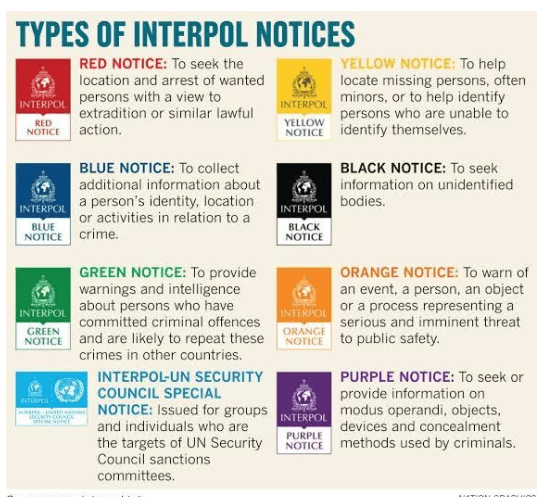
Daily Current Affairs IAS | UPSC Prelims and Mains Exam – 23rd January 2020
China Myanmar Economic Corridor
Part of: GS Prelims and GS Mains II– Foreign relations
In news:
- China’s President Xi Jinping will be visiting Myanmar to mark the 70th anniversary of the establishment of diplomatic relations between China and Myanmar.
- President’s visit will focus on the three pillars of the China Myanmar Economic Corridor (CMEC)— the Kyaukpyu Special Economic Zone, the China-Myanmar Border Economic Cooperation Zone and the New Yangon City.
From Prelims Point of View
China-Myanmar Economic Corridor (CMEC)
- China-Myanmar Economic Corridor (CMEC) is a number of infrastructure projects supporting connectivity between Myanmar and China. It is an economic corridor of the Belt and Road Initiative
- building road and rail transportation from Yunnan Province in China through Muse and Mandalay to Kyaukpyu in Rakhine State.
- Rakhine state is also in news due to Rohingya crisis
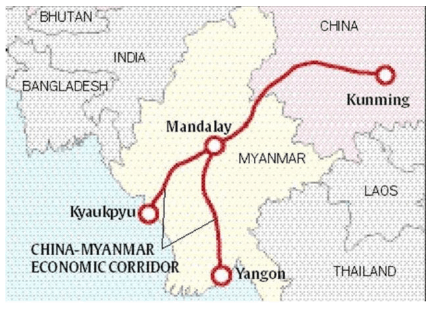
Daily Current Affairs IAS | UPSC Prelims and Mains Exam – 23rd January 2020
https://www.drishtiias.com/images/uploads/1579249718_image3.jpg
United Nations Military Observer Group for India and Pakistan (UNMOGIP)
Part of: GS Prelims Polity and GS Mains II–India’s Neighborhood relations
In news:
Imran Khan asks US and United Nations to help de-escalate tension between India, Pakistan
From Prelims Point Of View:
- India took Jammu Kashmir matter to the UN Security Council which established the United Nations Commission for India and Pakistan (UNCIP) to investigate the issues and mediate between the two countries.
- Following the cease-fire of hostilities, it also established the United Nations Military Observer Group for India and Pakistan (UNMOGIP) to monitor the cease-fire line.
India drops 10 ranks in Democracy Index
Part of: GS Prelims and GS Mains II– Democracy
In news:
- India slipped 10 places in the 2019 global ranking to 51st place.
- The average global score also recorded its worst value ever, down from 5.48 in 2018 to 5.44, driven by a sharp regression in Latin America and Sub-Saharan Africa, a lesser one in the Middle East and North Africa (MENA) region, and by stagnation in the remaining regions that were covered.
- The report, “A year of democratic setbacks and popular protest”, was done by The Economist Intelligence Unit — the research and analysis division of The Economist Group.
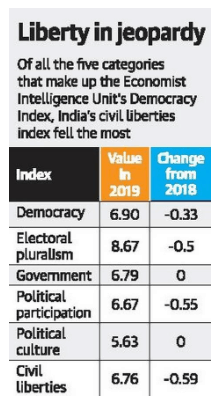
Daily Current Affairs IAS | UPSC Prelims and Mains Exam – 23rd January 2020
Middle East and North Africa (MENA)
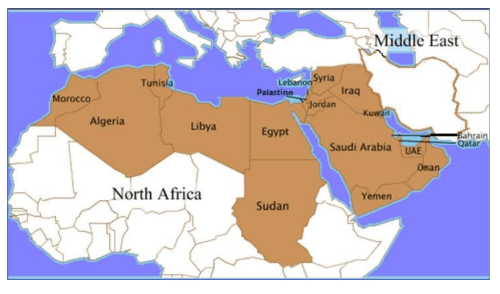
vvDaily Current Affairs IAS | UPSC Prelims and Mains Exam – 23rd January 2020
Miscellaneous Topics for Prelims
Brahmakalashothsava
- Brahmakalashothsava festival is celebrated in the ancient Chandkuru Sri Durga Parameshwari Temple annually in Polali, Dakshina Kannada district in Karnataka
Mein Kampf
- Mein Kampf (My Struggle or My Fight) is a 1925 autobiographical manifesto by Nazi Party leader Adolf Hitler.
- The work describes the process by which Hitler became antisemitic and outlines his political ideology and future plans for Germany.
On Speakers and disqualification
Landmark judgment in Kihoto Hollohan (1992)
- Upheld the validity of the Constitution’s Tenth Schedule, or the anti-defection law.
- This verdict had also made the Speaker’s order subject to judicial review on limited grounds.
Constitution Bench judgment (Rajendra Singh Rana, 2007)
- The Uttar Pradesh Speaker’s order refusing to disqualify 13 BSP defectors was set aside on the ground that he had failed to exercise his jurisdiction to decide whether they had attracted disqualification, while recognising a ‘split’ in the legislature party.
(MAINS FOCUS)
Indian Polity
Topic: General Studies 2:
- Parliament and State legislatures—structure, functioning, conduct of business, powers & privileges and issues arising out of these.
Speaker’s role in disqualification
Context:
The Supreme Court’s latest decision on the Speaker as the adjudicating authority under the anti-defection law.
About Anti-Defection Law
- The anti-defection law is contained in the 10th Schedule of the Constitution and was enacted by Parliament Constitution (52nd Amendment) Act, 1985.
- Legislators used to change parties frequently bringing in Political Instability and was also considered as betraying the mandate of voters (who voted for the legislator considering his political party)
- The purpose of 10th Schedule is to curb political defection by the legislators. There are two grounds on which a member of a legislature can be disqualified.
- One, if the member voluntarily gives up the membership of the party, he shall be disqualified.
- Second, if a legislator votes in the House against the direction of his party and his action is not condoned by his party, he can be disqualified.
- However, there is an exception – The 10th Schedule says that if there is a merger between two political parties and two-thirds of the members of a legislature party agree to the merger, they will not be disqualified.
- The Presiding officer of the House (Speaker/Chairman) is the adjudicating authority with regard to disqualification of legislators under the Tenth Schedule
Criticism of the anti-defection Law
- Curbs the freedom of speech & expression of law makers
- Tyranny of Political Parties: Legislators have to abide by the line taken by Political parties even it is against their own stand or against the interest of her constituency
- Role of the Speaker is biased: Speaker who is a member of a political party is often not neutral and comes under the influence of his political party instead of deciding the cases on merit
- Delay in decision making: several presiding officers have allowed defectors to bolster the strength of ruling parties and even be sworn in Ministers by merely refraining from adjudicating on complaints against them
Supreme Court Judgements in Kihoto Hollohan (1992) case:
- Five Judge Bench of SC upheld the validity of the Constitution’s Tenth Schedule, or the anti-defection law.
- It was also held in this case that a Speaker or a Chairman, acting Tenth Schedule, is a Tribunal and thus his discretionary powers were protected by Constitution.(dissenting minority view by Justice JS Verma who questioned the fairness of speaker in adjudication)
- This verdict had also made the Speaker’s order subject to judicial review on limited grounds and that mere procedural infirmities could not prompt judicial intervention.
- It was also held that judicial review cannot be available at a stage prior to the making of a decision by the Speaker/Chairman.
Recent Supreme Court judgement on the role of Speaker
Background: The top court was hearing the appeal of Congress leader against the Manipur High Court order. The High had refused to direct Speaker to decide on disqualification of another Congress legislator who had defected to BJP & made minister.
Following are the pronouncements of the SC in this case
- The Speakers should decide Tenth Schedule disqualifications within a reasonable period. Unless there were “exceptional circumstances”, disqualification petitions under the Tenth Schedule should be decided by Speakers within three months (This question on time period raised by two judge bench of Supreme Court in S.A. Sampath Kumar vs. Kale Yadaiah, 2016 case)
- Asked the Parliament to consider having an independent and permanent body to decide disqualification petition. Given the fact that a Speaker belongs to a particular political party, the Court mooted this idea, which requires an amendment to the constitution.
- Also, Speaker wasn’t adjudicating election disputes or disqualification of members under Articles 103/ 192/ 329 for good reason, because their fairness could be suspected.
Way Forward:
- The Constitution is called a living document because of its ability to grow and change with time and circumstances. Clearly, the Tenth Schedule has fallen short in fulfilling its objective of preventing defections and needs a relook.
- Parliament must fix this flaw and institute a tribunal recognising the significance of anti-defection provisions in upholding the sanctity of Parliament.
Connecting the dots
- Speakers role in deciding whether the bill is money bill or not
- Britain’s model of Speaker’s post
Agriculture & Environment
Topic: General Studies 3:
- Major crops-cropping patterns in various parts of the country,
- Issues related to direct and indirect farm subsidies and minimum support prices;
- Awareness in the fields of Bio-technology
- Conservation, environmental pollution and degradation, environmental impact assessment
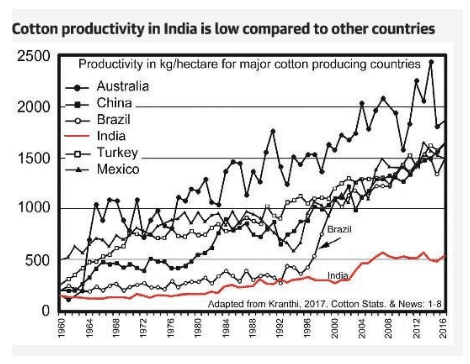
Daily Current Affairs IAS | UPSC Prelims and Mains Exam – 23rd January 2020
India’s Cotton Story
India’s Cotton Productivity is low in comparison to other major cotton producing nations in spite of India expected to be world’s largest cotton producer this year surpassing China
Genetically Modified (GM) pest resistant Bt cotton hybrids have captured the Indian market since their introduction in 2002. These now cover over 95% of the area under cotton, with the seeds produced entirely by the private sector.
India’s cotton production in 2019 is projected as the highest ever: 354 lakh bales. This threefold increase in cotton production during past two decades is used by proponent of GM crops to extend the technology to other crops as well
India is the only country that grows cotton as hybrids and the first to develop hybrid cotton back in 1970
Difference between hybrids and varieties
| Varieties (Used in Brazil) | Hybrids (Used in India since 1970s) |
| Varieties are those for which seeds are produced by self-fertilization. | Hybrids are made by crossing two parent strains having different genetic characters.
These plants have more biomass than both parents, and capacity for greater yields |
| Varieties can be propagated over successive generations by collecting seeds from one planting and using them for the next planting; | Hybrid seeds have to be remade for each planting by crossing the parents. So for hybrids, farmers must purchase seed for each planting. Increased dependence on seed companies |
| High Density Planting (HDP) Methodology: These varieties are planted at high density (5 kg seeds/acre) | Hybrids are planted at ten-fold lower density (0.5 kg seeds/acre). |
| They are compact and short duration. | hybrids in India are bushy and long duration |
| Lower boll production by compact varieties (5-10 bolls per plant) – compensated by high density | High boll production (20-100 bolls/plant) |
| Cotton is a dryland crop; therefore, shorter duration variety has a major advantage as it reduces dependence on irrigation | 65% of area under cotton in India is rain-fed. Farmers with insufficient access to groundwater in these areas are entirely dependent on rain. Thus risk associated with hybrid cotton cultivation is higher due to unpredictability of rains |
| Low requirement of fertilizer (100 kg/ha for varieties) | High fertilizer requirement: 200 kg/ha for hybrids |
| lLess vulnerability to damage from insect pests due to a shorter field duration. | High vulnerability to damage from insect pests due to a longer field duration. |
| Low water requirement | High water requirement |
| Low cost of seeds | High Cost of Hybrid seeds. Increased yield from a hybrid is supposed to justify the high price |
Hybrid model is inferior to the HDP model being used in other countries on three important counts: much lower productivity; higher input costs; and increased risk particularly for low resource farmers in rain-fed areas.
The steep increase in productivity for Brazil, from 400 to 1,000 kg/hectare lint between 1994 and 2000 coincides with the large-scale shift to a non-GM compact variety.
Why HDP model not adopted despite having advantages for India?
- During First Phase (From 1980 to 2002): Hybrids were promoted at the cost of Compact varieties. This was primarily due to weakness of agricultural research establishment who failed to identify the benefits of compact varieties
- Second phase (2002 onwards): During introduction of GM Bt hybrid seeds. However, the scope of evaluation by the GM regulatory process in India was narrow and did not take into account on the form in which it would be deployed (hybrids versus varieties)
Consequently, commercial Bt hybrids have completely taken over the market, accompanied by withdrawal of public sector cotton seed production.
The Indian cotton farmer today is left with little choice but to use Bt hybrid seed produced by private seed companies. The current annual value of cotton seed used for planting is about ₹2,500 crore, and that of lint cotton produced is ₹68,000 crore.
It is likely that production levels could have been much higher, with considerably lower risk and input costs, had compact varieties been developed and used in India, especially given the agricultural distress faced in India.
Conclusion
- We must be clear that the outcome of using a technology such as Bt is determined by the context in which it is deployed, and not just by the technology itself. Brazil (until 2012) and Turkey (up to the present) have achieved high productivity without the use of GM cotton by using alternative pest-management approaches.
- There is a need for better consultation in policy, be it agriculture as a whole or crop-wise. Socioeconomic and need-based considerations should be a part of GMO regulatory process in India.
Connecting the Dots
- Bt Brinjal Controversy
- Genetic Engineering in other fields – Medicines, disease prevention and cure.
(TEST YOUR KNOWLEDGE)
Model questions: (You can now post your answers in comment section)
Note:
- Correct answers of today’s questions will be provided in next day’s DNA section. Kindly refer to it and update your answers.
- Comments Up-voted by IASbaba are also the “correct answers”.
Q.1) Other than India and China, which one of the following groups of countries border Myanmar?
- Bangladesh, Thailand and Vietnam
- Cambodia, Laos and Malaysia
- Thailand, Vietnam and Malaysia
- Thailand, Laos and Bangladesh
Q.2) Consider the following pairs:
Community sometimes in the affairs of mentioned in the news
- Kurd Bangladesh
- Madhesi Nepal
- Rohingya Myanmar
Which of the pairs given above is/are correctly matched?
- 1 and 2
- 2 only
- 2 and 3
- 3 only
ANSWERS FOR 22 JAN 2020 TEST YOUR KNOWLEDGE (TYK)
| 1 | D |
| 2 | D |
| 3 | A |
MUST READ
About reviving Economy:
About Myanmar’s growing dependence on China:
About WHO:
About Climate Action:














